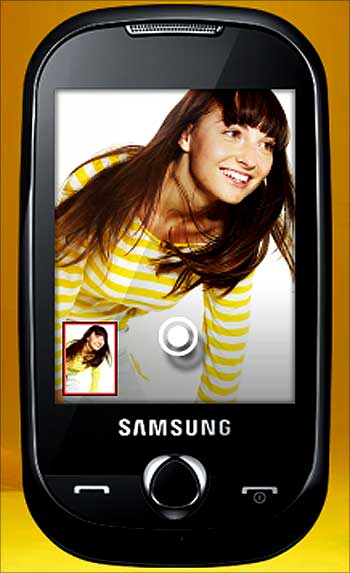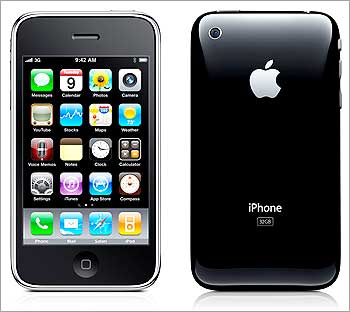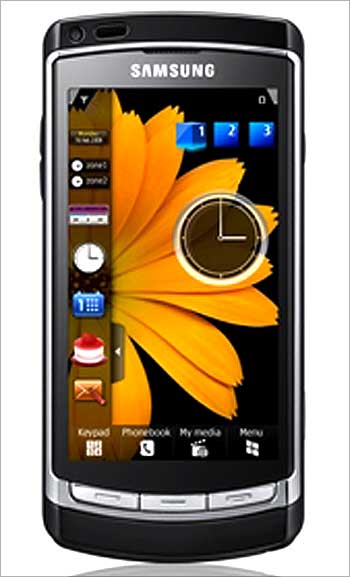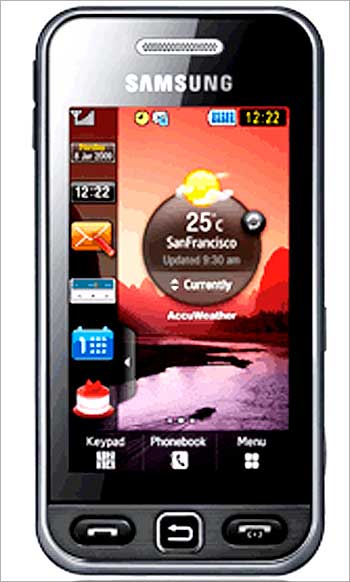
The price war in the touch screen mobile phone market in India has just begun. While Samsung has created a stir with Corby, which it launched a few weeks ago, Nokia is planning to catch up fast with the 5230 and 5530 models.
At the moment, however, Samsung has an edge due to its first mover advantage. Corby, available in four models, is priced below Rs 10,000, much lower than Taiwanese firm HTC's phones for less than Rs 15,000. And unlike Apple or HTC, which are targeting business executives, Samsung is seeking to change the market dynamics by focusing on teenagers and youth.
To attract their attention, the phones come in funky colours. Corby also offers users on the move access to Facebook, Twitter and MySpace; they can update their blogs on the phone without having to go to a PC; double the size of a picture by touching the screen and can change the colour and look of the phone by using colour jackets.

Says Asim Warsi, Samsung India's general manager, marketing: "Touch pad provides a new way of engaging with a mobile phone."
But Samsung may not have a free run for long. Nokia, the country's largest mobile phone manufacturer, will shortly launch Nokia 5230 (Rs 10,000) and Nokia 5530 XpressMusic (Rs 12,559). Vipul Sabharwal, sales director of Nokia India, says, "Nokia is focused on taking the touch experience to the masses by launching products at competitive prices".
Why this dash for a market that currently constitutes just two per cent of mobile GSM phone sales? The reason is simple: the industry expects touch-phone sales to more than double this year to two million compared with around 800,000 last year. And the expectation is that the market for such phones will grow by another 100 per cent next year.
Says Warsi: "The touch screen segment is growing fast in a market where overall mobile phone sales are flat. It also helps in increasing our average selling price per phone and therefore share in terms of value."

Samsung's strategy has been simple. In January last year, the company had a volume share of only 7 per cent of the GSM mobile market -- not an impressive number in a market dominated by Nokia. So the challenge was to increase market share when the market was not really growing.
Touch screen phones provided the magic formula. Samsung realised that the market was changing -- consumers were looking for a fresh new way of engaging with the phone, wanted a new user interface and of course a larger screen so that they could see e-mails, pictures and videos more clearly than what normal phones offered.
To its advantage, Apple's iconic iPhone had changed the mobile phone world. Thanks to its aggressive marketing and hype, everyone understood what touch screen was all about.
The only problem was the entry barrier -- these phones were available in India for over Rs 25,000, that too bundled with the operator and were targeted at the business executive market.

That was the opportunity Samsung was waiting for -- the opportunity of gaining leadership in the touch screen space by targeting the youth who are not averse to changing their phones and are open to experimenting with new formats.
So while it launched a business phone with a touch screen (Omnia at Rs 32,000) last year, it followed it up with the affordable Star at around Rs 11,000.
Star, launched in August, was a big hit with its big screen, 3.2 megapixel camera, rotating display system etc. The positioning worked for Samsung, which saw its market share move up by 14.2 per cent. And 10 per cent of its total sales now come from touch phones.
Samsung says it has over 44 per cent share in the Indian touch screen market.
Warsi says to cash in on the success, Samsung is now offering a larger range of models (up from two last year to 10 now) at varying price points.
The research before launching Corby showed that about 40 per cent of the youth who have a mobile phone buy GPRS-enabled ones, and half of them have activated GPRS services.

Nokia's Sabharwal says that the company's strategy is to provide mobile interfaces that consumers want - there are some consumers who like the qwerty key interface, others like to use the stylus while some want to use the touch screen.
Nokia's research has shown that touch interface is popular on devices with advanced multimedia features like web browsing, music on the go, creating personalised musical play lists among, others. And touch screen provides flexibility by enabling users to avoid using a mouse or a touch pad.
But will the battle for touch screens spill out to even lower price points -- especially in the Rs 5,000 to Rs 7,000 price category which forms a very large market? Warsi says not for the time being, while Nokia harps on taking technology to the masses.
But analysts say it's only a matter of time before the shift from phones with keys to touch screens becomes as dramatic as the shift in the TV industry from cathode ray tube TV sets to LCDs.